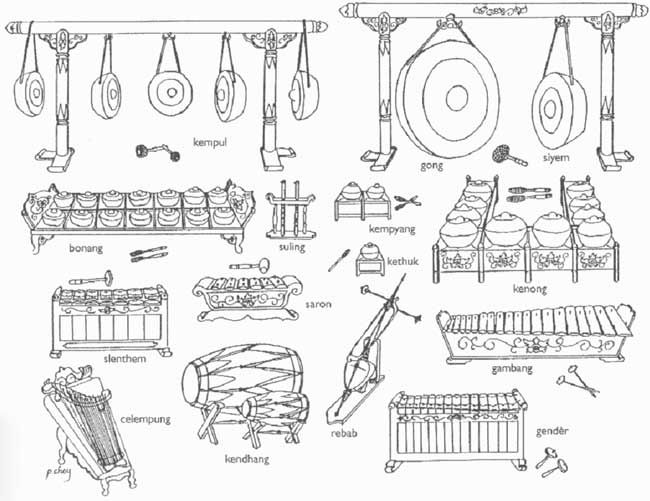
Dinner Conversation about Gamelan Music
1000- words essay #2My parents invited their friend, Cindy, over for dinner. She is very educated in business and economics because that is what she studied in college, but she is also well-versed in the performing arts, specifically dance. In college, she was a part of a jazz dance group and played the guitar. I am glad my parents invited her over for dinner because I know she is going to really like hearing about my Indonesian culture and dance class. When she was over, she asked me what I found the most interesting in learning about Javanese music and dance traditions. I am really interested in music, so I found the music traditions of central Java to be the most fascinating. In Java, the musicians play gamelan, which is an ensemble of musical instruments that mainly consists of percussive instruments. These instruments are mainly made out of bronze, brass, or iron. The musical style of the Javanese gamelan originated in Yogyakarta and Surakarta, two cities in Java. Gamelan music is considered very sacred and spiritual and is well-liked among the citizens of Java. After the establishment of the Republic of Indonesia, the government-supported music and the arts.
There are four groups of instruments: the balungan, the punctuating group, the elaborating group, and the tempo and dynamic group. The saron and slenthem are a part of the balungan group that plays the melody and is the “backbone” of the composition. The gong is a part of the punctuating group because it plays on certain beats in the melody. The peking is a part of the elaborating group that performs the melody at a faster pace. The primary drum played is the kendhang is a part of the tempo and dynamic group that controls the tempo. There is typically a singer that accompanies the Javanese gamelan. My favorite part of class thus far was when I got to play some of the gamelan instruments. I really enjoyed getting the chance to play the composition with the rest of the class and it was really nice to see how well all the instruments blend well together. The gong was my favorite instrument that I played because it makes this loud vibrating sound.

The tuning of the gamelan instruments is unique and has two tuning systems. One tuning system is slendro where there are five tones in an octave. The other tuning system is pelog where there are seven tones in an octave. I found it interesting that no two gamelan instruments are going to sound alike because the instrument tuners do not follow a standard pitch. However, the tuners make sure the pitch and scale match within the gamelan.
Within the Javanese community, there are two ways to learn music. The people in the court learn through the institutions, like the Sekolah Tinggi Seni Indonesia (STSI) school, that have access to government funding and have a certain prestige. The students typically learn about the notation and how to read music as it is essential to learn how to play gamelan instruments. Gamelan music was not always notated, musicians learned the pieces aurally. The people in the villages learn weekly from a teacher who learned from an institution. There are many ensembles in the village that perform on the Radio Republik Indonesia (RRI), weddings, and after the birth of a child. There may be more serious ensembles that participate in gamelan competitions, but there are also relaxed and fun gatherings with a gamelan ensemble with dancing. A nice aspect of gamelan music is that there is a lot of interaction between gamelan ensembles that bridge the gap between the rich and poor.
Originally, gamelan music was influenced by the Hindu and Buddhist cultures. After Indonesia’s independence, the gamelan music compositions changed and became more light-hearted. Gamelan music has been gradually moving away from the traditional court pieces and playing more lively pieces. The pieces in the gamelan music competitions in the wayang pieces have both become more vibrant. This disregards the custom of starting with serious pieces and ending with more vivacious pieces. Some institutions, specifically the STSI and ASKI schools encourage and teach their students’ new styles of music. Also, the musicians that play on the Radio Republik Indonesia perform a mix of traditional court songs with a mix of popular music that has been influenced by the Western culture.
Even though gamelan has gradually decreased in popularity, it is still crucial in the Javanese culture and played at wayang, a shadow puppet play, dances, and ritual ceremonies. Gamelan helps tell a story and set the mood of the corresponding action in a play or in a dance. Specifically, in Javanese court dances with battles like in srimpi, the intense music helps express the emotion and action, especially because the dancers do not show emotion on their faces. Even when I am learning the Javanese dance during class, playing the music while dancing always helps to set the tone and movements of the dance. The way the Javanese culture intertwines with the Javanese music shows how prevalent music and the performing arts are in Java. A Javanese citizen has to study the culture and traditions to earn and feel like an official member of the Javanese community. Studying and practicing Javanese music is almost like an introduction to the Javanese culture and values. This can make oneself feel a part of the Javanese community and culture and become a part of their identity.
Overall, since I am interested in learning about different musical styles and instruments, I find the gamelan music to be interesting in how it intertwines with the Javanese culture. My parent’s friend, Cindy, was really interested in gamelan music and the different types of instruments. She told me that she wants to try and see if there are any nearby lessons to learn some of the instruments.
Written by Ishani Dave
Categories
Calendar
| M | T | W | T | F | S | S |
|---|---|---|---|---|---|---|
| 1 | ||||||
| 2 | 3 | 4 | 5 | 6 | 7 | 8 |
| 9 | 10 | 11 | 12 | 13 | 14 | 15 |
| 16 | 17 | 18 | 19 | 20 | 21 | 22 |
| 23 | 24 | 25 | 26 | 27 | 28 | 29 |
| 30 | ||||||